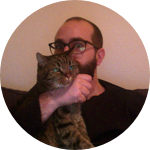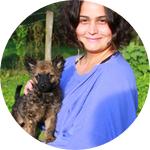The LilBubome project successfully raised $8,225 from 233 backers in a fantastic display of science communication on an international stage. The project is a case study in what's required to be successful, so we interviewed the researchers to combine anecdotal advice and analytics data to show the story behind this successful experiment.
Daniel Ibrahim, Dario Lupianez, and Uschi Symmons first got the idea for their experiment when they were exchanging internet videos of cute cats. The three postdoctoral researchers at the Max Planck Institute for Genetics were fascinated - was there more going behind this cute cat, Lil Bub, and its unique looks that genome science could reveal?
The idea was floated to sequence the genome of Lil Bub to understand the interesting physiology. An email was fired off to Lil Bub's owner, and after some friendly exchanges and a few weeks later, the project had legs. The team knew that they could do much of this work in their free time, their daily expertise revolves around rare genetic mutations.
The only thing missing was $6,000 in funding for using an Illumina genome sequencer and some reagents to gather the genome data. And so they committed to raising the funding for the LilBubome.
Stumbling upon, and then refining, the right idea
Early on while developing the idea, the team gathered lots of feedback from their peers and colleagues. It took them constantly talking to new people to understand what made the Lil Bubome so interesting.
We knew we were on the right path, and so then the only thing that we were missing was to get this started. But, what can I say, at some point we didn't know which direction to go because everything was suddenly new for us. Feedback was so helpful for this.
Getting specific
One of the biggest challenges was turning the idea into a compelling story. This took effort, but paid off hugely as the video has now been watched over 150,000 times across websites like Gizmodo, Reddit, Buzzfeed, and more. It's evidence that taking the time to think about story behind the science will help connect to a larger audience.
Launching the campaign
The outreach campaign was a whirlwind of excitement, which steadily grew in momentum and energy until the final pledge that pushed the project over. In total, 248 backers pledged $8,225 to allow the project to move forward. Blog posts, press releases, Reddit AMAs, social media, and international press coverage all contributed to success, but it started by building momentum with their immediate networks.
The Researchers
Quick Stats
- $8,225 raised
- $196 pledged per day
- 248 backers
- 24,249 pageviews
- 132 traffic sources
Campaign Timeline
| Day 1 |
Project Launch on facebook and twitter (link) 4% Funded |
| Day 3 |
Lilbubome.wordpress blog post (link) 10% Funded |
| Day 13 |
Article in The Node (link) 21% Funded |
| Day 15 |
Project Featured in Experiment Newsletter 28% Funded |
| Day 21 |
LilBub Official Facebook and Twitter Posts (link) 53% Funded |
| Day 34 |
Reddit AMA (link) 87% Funded |
| Day 35 |
Article in Der Spiegel (link) 107% Funded |
| Day 38 |
Article in Gizmodo (link) 115% Funded |
| Day 42 |
Campaign ends, articles in Buzzfeed and Washington Post (link) (link) 126% Funded |
Drumming Up Momentum
The project unfolded with many small events driven by their outreach to relevant audiences, culminating in widespread press coverage across many science related websites and mass media newspapers like Der Spiegel and Washington Post.

I think something similar happened with a Gizmodo piece. It was great to have a relatively large blog writing about it. Because once you're on a frequented site, people just copy and get interested. I think a colleague of ours told us that we are on Washington Post and we were like, "What!? How did that happen?" We never noticed this, so he's sending me a scan from a newspaper article from Santiago, Chile, that he got. That was a bit surreal.


Who Are The Backers?
In order to meet the funding goal, the project would have to average $150 in pledges every day of the campaign. They found that backers who came from targeted and specific outlets (related to cats or science) pledged more, meaning their targeted outreach ended up driving a lot of pledges.
Table 1: A sample of 80 of the 283 backers and the traffic referrals
| Source | Backers | Total | Average | % Total | % Backers |
|---|---|---|---|---|---|
| 36 | $1114 | $31 | 22.6% | 28.8% | |
| Gizmodo | 10 | $320 | $32 | 6.5% | 8.0% |
| 9 | $225 | $25 | 4.6% | 7.2% | |
| Catster | 3 | $225 | $75 | 4.6% | 2.4% |
| Lilbubome.wordpress | 5 | $206 | $41 | 4.2% | 4.0% |
| 6 | $155 | $26 | 3.1% | 4.8% | |
| GenomeWeb | 2 | $125 | $63 | 2.5% | 1.6% |
| Mentalfloss | 3 | $120 | $40 | 2.4% | 2.4% |
| De Spiegel | 3 | $100 | $33 | 1.2% | 2.4% |
| 3 | $75 | $25 | 0.9% | 2.4% |
Eventually it was just people giving money. We wanted to thank everyone personally, but I must say I was just amazed by everyone who gave something because it’s really cool and actually for one of the purposes of this crowd funding campaign was also communication so I guess I rather have a hundred and seven people giving twenty dollars than fifteen giving two hundred and fifteen.
On Science Outreach
One of the biggest goals of this campaign was to also effectively communicate science, and to teach others about genetics, mutations, and Lil Bub. Instead of thinking of fundraising and communication as being at odds, they realized that successful fundraising is an outcome of effective communication.

On Becoming Better Scientists
With outreach, we were motivated to do it well. As soon as we got feedback from other strangers, we wanted to answer and then we would do it immediately. I remember getting up one morning and getting a half critical comment from a backer and, I don’t know, I just brushed my teeth and set up an email and wrote immediately just to be as quick as possible. You just start doing it like that. The more feedback you get, the more quickly you get to produce things that you can share online.
Key Takeaways


